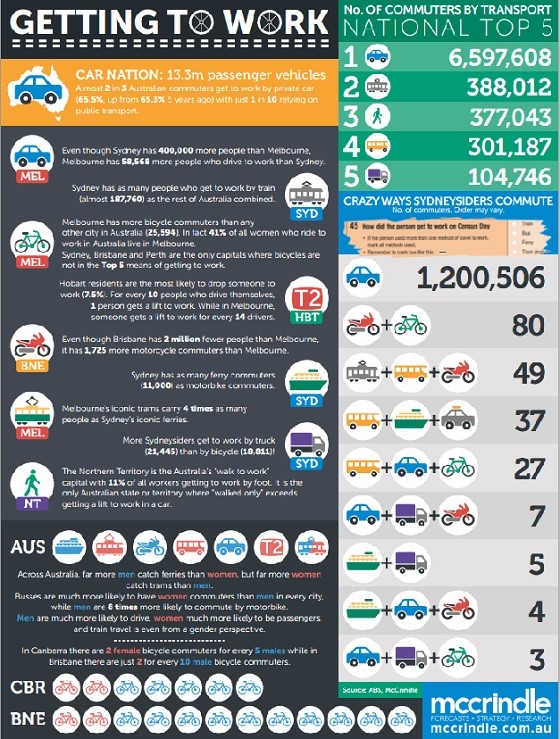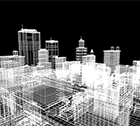
Mccrindle Research released an analysis of national journey to work data yesterday. The headline finding is just 10% of commuters across Australia travel to work by public transport (1).
Most of the findings are familiar but one is especially interesting. The researchers say they found that “more than half of Australians (54 per cent) state that the reason that they don’t use public transport is that there is no service or none at the right time for them.”
The implication is that given a higher level of service, over half of workers who currently drive would use trains, buses and trams instead. Add that to those who already use public transport and potentially nearly two thirds of the workforce could commute by transit.
While it needs to be borne in mind that the journey to work only accounts for around a fifth of all trips, that’s nevertheless an enormous opportunity. All it seemingly needs is better public transport.
But unfortunately it’s not that simple. When respondents say they don’t use public transport because it isn’t good enough, they’re implying they’d use it if only it were better. So what they mean by “better” is a crucial issue.
I think they implicitly mean it has to be better than their current choice i.e. driving. I think they also implicitly assume they’d have to have the same level of service – or better – that’s currently provided for work trips to the Central Business District (CBD) by public transport.
Moreover I expect most subliminally assume a train or light rail service operating in its own dedicated right-of-way.
That’s not surprising because CBD trips account for a very high proportion of all public transport work trips in Australia’s capitals and most of them are made by train. The reasons for that are straightforward; in Australia’s largest cities:
- The CBD is the singular focus of the entire radial metropolitan transit system. In most cities trains carry the largest number of passengers.
- The CBD is far and away the largest and densest single concentration of jobs and other activities in the metropolitan area.
- The attractiveness of commuting by car to the CBD is reduced dramatically by traffic congestion and high parking costs; these are largely a direct consequence of the sheer density of the CBD.
Because the CBDs in Australian cities cover such a small area (around one square mile) it’s feasible to provide services at relatively high frequencies. For example, a number of rail lines to Melbourne’s CBD now operate at 10 minute frequencies for much of the day.
The problem for policy-makers though is that reproducing elsewhere in the metropolitan area the transit-friendly conditions that apply in the CBD is very, very difficult.
Obviously no other location has every metropolitan rail line converging on it. No other location has as many jobs either.
While the great majority of jobs in Australian cities aren’t located in the CBD, they’re mostly dispersed across the suburbs. Most aren’t in major centres but in a multiplicity of smaller centres. These are the jobs that workers overwhelmingly choose to drive to.
Given current land use patterns, providing public transport for the journey to work that would be attractive enough to tempt 54% of drivers out of their cars would be extraordinarily expensive to build and operate.
For example, although likely to cost around $4 billion, modelling for Melbourne’s proposed 12 km Rowville rail line indicates it would only increase public transport’s mode share at the metropolitan scale by 0.1% in 2046 (see Is one boondoggle as good as another?).
But cost isn’t the only barrier. A key reason CBD workers choose to take public transport is because it’s one of the few places where trains, buses and ferries are competitive with cars. That’s primarily because congestion and parking costs reduce the attractiveness of driving.
In a big place like Sydney only 17.8% of CBD commuters drive to work. In Melbourne’s somewhat smaller CBD the proportion is bigger (25.8%). But in smaller metros many more CBD workers drive – 46.7% in Perth and 54.4% in Adelaide (see Does Sydney’s CBD need another freeway?).
Generating wholesale mode shift on the scale implied by the Mccrindle study requires more than better public transport. It also requires reducing the attractiveness of driving relative to transit.
That doesn’t mean there isn’t scope to increase incrementally the share of commutes captured by public transport through appropriately targeted policies (e.g. see How can public transport work better in cities?).
But it highlights a number of important points. First, the scale of the task of providing public transport attractive enough to win large numbers of commuters away from their cars is immense. Second, it won’t happen on any sort of scale unless cars are made less competitive vis a vis other modes e.g. by congestion pricing.
The most important point though – and one that’s too often neglected – is that cars will continue to be the main way commuters get to work for many decades to come. That’s true even if the prospects of autonomous vehicles are ignored.
Finding ways to manage driving better than we do now has to be one of the top immediate priorities of city managers. Pricing road use should be at the top of their list.
_______________________________________
- It depends how the numbers are constructed but I think 10% is a little low. Note that public transport’s share of work trips is almost 17% when averaged across just the capital cities – see Is public transport winning the battle for commuters?








Crikey is committed to hosting lively discussions. Help us keep the conversation useful, interesting and welcoming. We aim to publish comments quickly in the interest of promoting robust conversation, but we’re a small team and we deploy filters to protect against legal risk. Occasionally your comment may be held up while we review, but we’re working as fast as we can to keep the conversation rolling.
The Crikey comment section is members-only content. Please subscribe to leave a comment.
The Crikey comment section is members-only content. Please login to leave a comment.